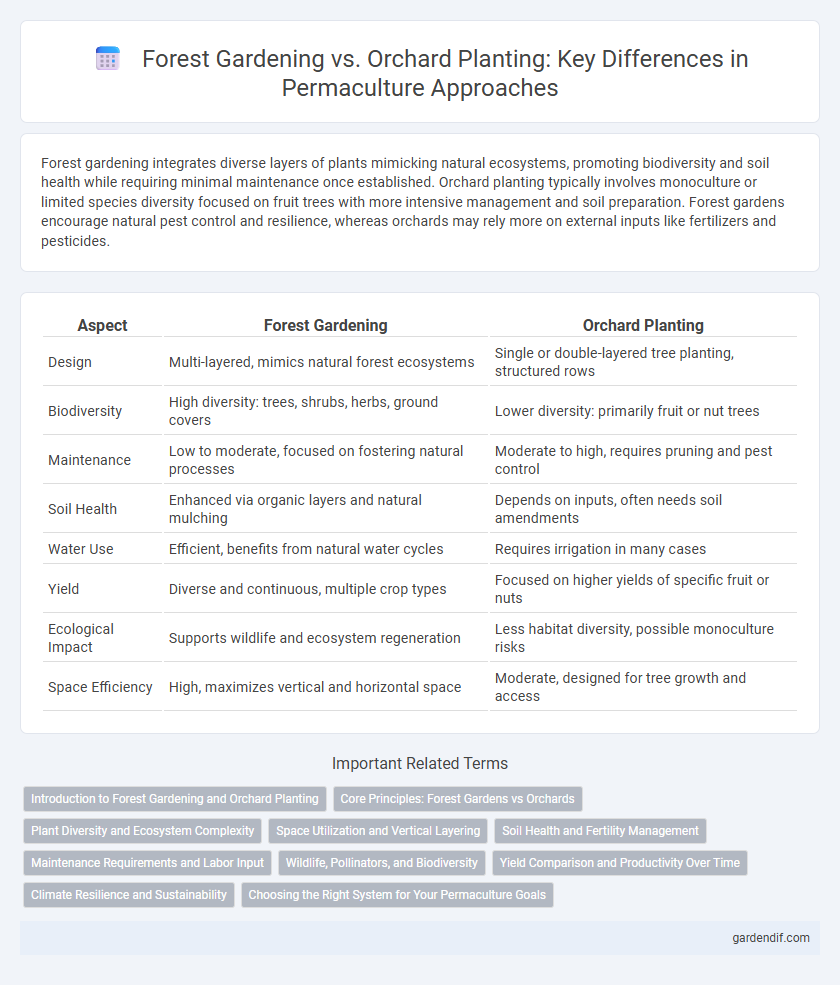
Forest Gardening vs Orchard Planting Illustration
Forest gardening integrates diverse layers of plants mimicking natural ecosystems, promoting biodiversity and soil health while requiring minimal maintenance once established. Orchard planting typically involves monoculture or limited species diversity focused on fruit trees with more intensive management and soil preparation. Forest gardens encourage natural pest control and resilience, whereas orchards may rely more on external inputs like fertilizers and pesticides.
Table of Comparison
| Aspect | Forest Gardening | Orchard Planting |
|---|---|---|
| Design | Multi-layered, mimics natural forest ecosystems | Single or double-layered tree planting, structured rows |
| Biodiversity | High diversity: trees, shrubs, herbs, ground covers | Lower diversity: primarily fruit or nut trees |
| Maintenance | Low to moderate, focused on fostering natural processes | Moderate to high, requires pruning and pest control |
| Soil Health | Enhanced via organic layers and natural mulching | Depends on inputs, often needs soil amendments |
| Water Use | Efficient, benefits from natural water cycles | Requires irrigation in many cases |
| Yield | Diverse and continuous, multiple crop types | Focused on higher yields of specific fruit or nuts |
| Ecological Impact | Supports wildlife and ecosystem regeneration | Less habitat diversity, possible monoculture risks |
| Space Efficiency | High, maximizes vertical and horizontal space | Moderate, designed for tree growth and access |
Introduction to Forest Gardening and Orchard Planting
Forest gardening integrates diverse layers of edible, medicinal, and perennial plants mimicking natural woodland ecosystems for sustainable food production. Orchard planting emphasizes monoculture or limited-species tree cultivation primarily for fruit yield and easier management. Both methods contribute to permaculture by enhancing biodiversity, soil health, and long-term productivity through distinct ecological approaches.
Core Principles: Forest Gardens vs Orchards
Forest gardening emphasizes biodiversity and polyculture, integrating multiple layers of plants such as canopy trees, shrubs, herbs, and groundcovers to create a self-sustaining ecosystem. Orchard planting focuses on monoculture or limited species cultivation, prioritizing high yield and ease of harvesting over ecological complexity. Core principles of forest gardening include mimicking natural forest structures and promoting soil health, whereas orchards prioritize controlled spacing, pruning, and pest management.
Plant Diversity and Ecosystem Complexity
Forest gardening emphasizes high plant diversity and multilayered vegetation, creating a complex ecosystem that mimics natural forests with trees, shrubs, herbs, and ground cover. Orchard planting typically features monoculture or limited species selection, prioritizing fruit tree production with less emphasis on understorey diversity. The increased plant variety in forest gardens supports enhanced biodiversity, soil health, and resilience against pests and diseases compared to conventional orchards.
Space Utilization and Vertical Layering
Forest gardening maximizes space utilization by mimicking natural ecosystems with multiple vertical layers, including canopy, understory, shrubs, herbs, and ground cover, enabling higher biodiversity and productivity in limited areas. Orchard planting generally focuses on single-layer tree rows, often underutilizing vertical space and ground-level niches. Incorporating vertical layering in forest gardening enhances resource efficiency, soil health, and yields compared to traditional orchard systems.
Soil Health and Fertility Management
Forest gardening enhances soil health by mimicking natural ecosystems, promoting diverse plant layers that improve nutrient cycling and organic matter accumulation. Orchard planting often relies on monoculture trees, which can deplete soil nutrients and require external inputs for fertility management. Integrating nitrogen-fixing plants and mulching in forest gardens supports sustainable soil fertility and long-term ecosystem resilience.
Maintenance Requirements and Labor Input
Forest gardening relies on a multi-layered planting system that mimics natural ecosystems, significantly reducing maintenance requirements through self-sustaining plant interactions and minimal soil disturbance. Orchard planting demands regular pruning, pest control, and soil management, resulting in higher labor input to maintain tree health and optimize fruit production. The complexity and diversity of forest gardens promote resilience and lower long-term labor compared to the more intensive management of traditional orchards.
Wildlife, Pollinators, and Biodiversity
Forest gardening enhances wildlife habitats by mimicking natural ecosystems with diverse layers of native plants, supporting a wide range of pollinators and increasing overall biodiversity. Orchard planting typically focuses on single-species fruit trees, which can limit habitat variety and reduce the presence of beneficial insects. Integrating forest garden principles promotes soil health, attracts diverse pollinator species, and creates a resilient environment for wildlife compared to monoculture orchards.
Yield Comparison and Productivity Over Time
Forest gardening mimics natural ecosystems by integrating diverse layers of perennial plants, resulting in stable, resilient yields that improve over time due to soil enrichment and biodiversity. Orchard planting typically emphasizes mono-cropping of fruit trees, offering higher initial yields but requiring more maintenance and often experiencing productivity decline without sustainable practices. Over the long term, forest gardens tend to produce a more consistent and sustainable yield by enhancing ecosystem services and reducing input needs compared to conventional orchards.
Climate Resilience and Sustainability
Forest gardening enhances climate resilience by mimicking natural ecosystems, promoting biodiversity, and improving soil health, which increases adaptability to extreme weather conditions. Orchard planting, while productive, typically relies on monoculture practices that can deplete soil nutrients and reduce ecosystem diversity, making it less sustainable in changing climates. Integrating diverse perennial species in forest gardens creates self-sustaining systems that require fewer inputs and support long-term environmental stability.
Choosing the Right System for Your Permaculture Goals
Forest gardening integrates diverse layers of plants, fostering biodiversity and resilience through perennial crops, whereas orchard planting emphasizes monoculture or few tree species focused on maximum fruit production. Prioritizing a forest garden suits permaculture goals of ecosystem restoration and long-term sustainability, while an orchard aligns better with focused productivity and ease of management. Assessing available space, soil health, and desired yield guides the choice between these complementary systems in permaculture design.
Forest Gardening vs Orchard Planting Infographic

 gardendif.com
gardendif.com